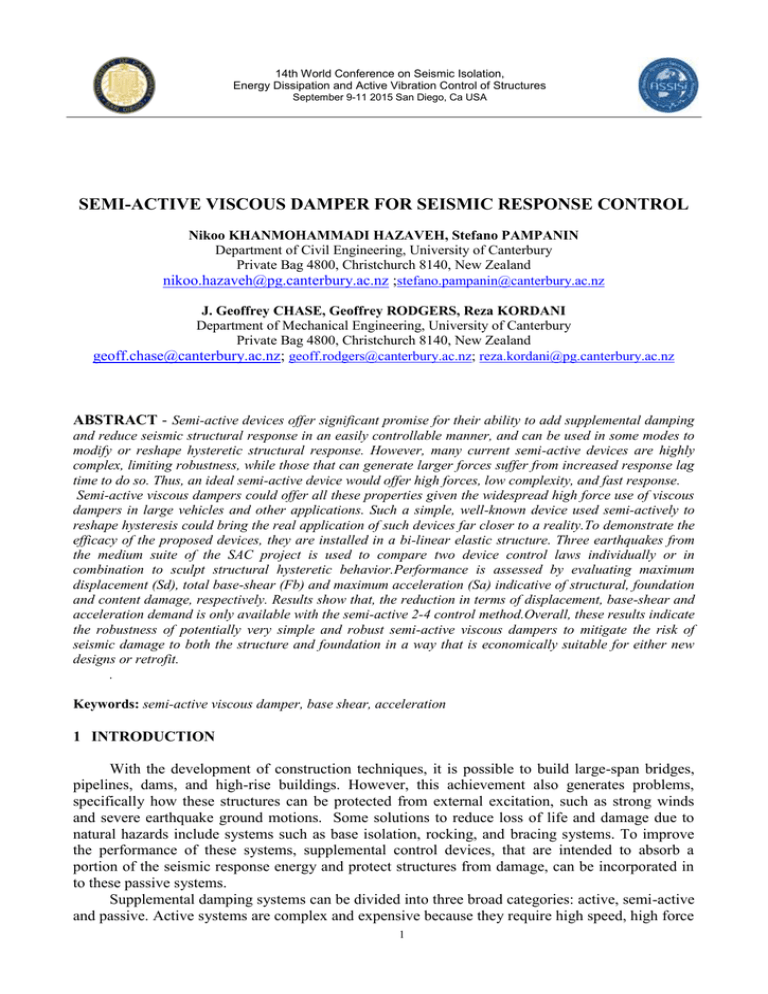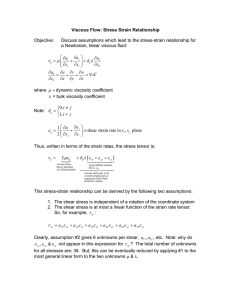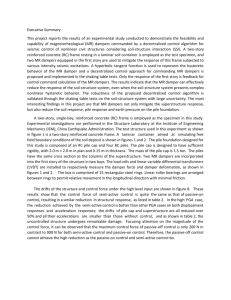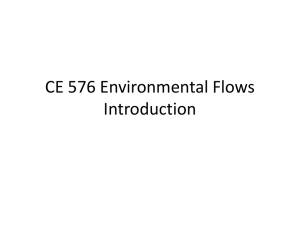12658684_PaperFormat-14wcsi-nikoo-7.13.15-JGC.doc (807Kb)
advertisement

14th World Conference on Seismic Isolation, Energy Dissipation and Active Vibration Control of Structures September 9-11 2015 San Diego, Ca USA SEMI-ACTIVE VISCOUS DAMPER FOR SEISMIC RESPONSE CONTROL Nikoo KHANMOHAMMADI HAZAVEH, Stefano PAMPANIN Department of Civil Engineering, University of Canterbury Private Bag 4800, Christchurch 8140, New Zealand nikoo.hazaveh@pg.canterbury.ac.nz ;stefano.pampanin@canterbury.ac.nz J. Geoffrey CHASE, Geoffrey RODGERS, Reza KORDANI Department of Mechanical Engineering, University of Canterbury Private Bag 4800, Christchurch 8140, New Zealand geoff.chase@canterbury.ac.nz; geoff.rodgers@canterbury.ac.nz; reza.kordani@pg.canterbury.ac.nz ABSTRACT - Semi-active devices offer significant promise for their ability to add supplemental damping and reduce seismic structural response in an easily controllable manner, and can be used in some modes to modify or reshape hysteretic structural response. However, many current semi-active devices are highly complex, limiting robustness, while those that can generate larger forces suffer from increased response lag time to do so. Thus, an ideal semi-active device would offer high forces, low complexity, and fast response. Semi-active viscous dampers could offer all these properties given the widespread high force use of viscous dampers in large vehicles and other applications. Such a simple, well-known device used semi-actively to reshape hysteresis could bring the real application of such devices far closer to a reality.To demonstrate the efficacy of the proposed devices, they are installed in a bi-linear elastic structure. Three earthquakes from the medium suite of the SAC project is used to compare two device control laws individually or in combination to sculpt structural hysteretic behavior.Performance is assessed by evaluating maximum displacement (Sd), total base-shear (Fb) and maximum acceleration (Sa) indicative of structural, foundation and content damage, respectively. Results show that, the reduction in terms of displacement, base-shear and acceleration demand is only available with the semi-active 2-4 control method.Overall, these results indicate the robustness of potentially very simple and robust semi-active viscous dampers to mitigate the risk of seismic damage to both the structure and foundation in a way that is economically suitable for either new designs or retrofit. . Keywords: semi-active viscous damper, base shear, acceleration 1 INTRODUCTION With the development of construction techniques, it is possible to build large-span bridges, pipelines, dams, and high-rise buildings. However, this achievement also generates problems, specifically how these structures can be protected from external excitation, such as strong winds and severe earthquake ground motions. Some solutions to reduce loss of life and damage due to natural hazards include systems such as base isolation, rocking, and bracing systems. To improve the performance of these systems, supplemental control devices, that are intended to absorb a portion of the seismic response energy and protect structures from damage, can be incorporated in to these passive systems. Supplemental damping systems can be divided into three broad categories: active, semi-active and passive. Active systems are complex and expensive because they require high speed, high force 1 actuators and significant energy. Passive solution avoids these issues, but cannot provide any adaptive capability to different responses and is tuned to a structure’s design parameters. Therefore, passive solutions may not be robust to changes in structural response. An interesting and appealing compromise is given by semi-active control systems that require only a relatively very small external power source for operation but offer the ability to adapt to structural response. Semi-active devices have two main advantages over passive or active control devices. First, they do not require a large external power source for operation, as active devices do. This characteristic is because of changes in the physical space or material properties that create their dissipative forces. Therefore, semi-active devices cannot in principle destabilize the structure because they do not add energy to the system, but simply absorb or store vibratory energy [Chase et al. 2006]. Second, the smart control of these devices makes them more able to provide a reliable, lowdamage system than passive devices, regardless of the uncertainties of input ground motions. This aspect is enhanced by the ability to sculpt device hysteretic behaviour in some, but not all, semiactive devices. The potential of many classes of semi-active devices and control methods, including variable stiffness and variable damping, to mitigate damage during seismic events is well documented [Jansen and Dyke 2000, Hezaveh et al 2015, Barroso et al. 2003, Yoshida and Dyke 2004, Chase et al. 2006, Mulligan et al. 2007, Mulligan et al. 2010]. Many prior semi-active devices have been air or fluid based systems based on the principles of variable stiffness [Chase et al. 2006, Rodgers et al. 2007, Mulligan et al. 2009, Mulligan et al 2010], but were complex and could not produce the very large control forces often required for controlling structures. A further, potentially more robust, means of achieving such a semi-active device is to use a controllable, electromechanical, variableorifice valve to alter the resistance to flow of a conventional hydraulic fluid damper. Feng and Shinozuka [Feng et al, 1993] were the first to consider this concept. However, the extra plumbing and the low resolution orifices made this device essentially very similar to the resettable device of Jabbari and Bobrow [2002], and produced primarily on/off or high/low control without the ability to realize much of the potential benefit. Moreover, the ability to sculpt the hysteretic response of a device, and thus of the whole structure, is only obtained by direct control of its the device motion in each direction (with sign) [Chase et al. 2006]. Semi-active devices can also be highly complex and may have limited force. To address these shortcomings, Hazaveh et al [2014] evaluated the concept of semi-active viscous dampers and examined three types of device control laws (a 1-4, 1-3 and 2-4) to sculpt hysteretic behaviour. The semi-active viscous damper appeared to be an appealing solution for reducing seismic response, with minimal risk of structural or foundation damage. However, Hazaveh et al [2014] clarified the effect of the semi-active viscous damper on the just a linear, spectral analysis structure. In this study, the effects of semi-active viscous devices on bi-linear elastic structures are investigated, as such structures are increasingly common based on rocking structures or connections. The effects of different control laws on the displacement, base shear and acceleration of the structure are evaluated over earthquake ground motions from the SAC LA medium suite. The goal is to identify the range of potential reductions in displacement (structural damage), base shear (foundation damage and cost) and acceleration (content damage) with this type of device. 2 ANALYSIS This paper investigates the relative effectiveness of the semi-active devices on the seismic response of a bi-linear elastic Single Degree of Freedom (SDOF) structural system fitted with a semi-active variable orifice viscous damper. The model structure details are shown in Table 1. The semi-active viscous damping device has limited capacity and can add up to 15% additional damping to the structure when activated, and ~0% when all valves are left open. 2 Table 1- Model structure details Mass (ton) 10 Inherent damping Ductility 5% 2 Period (Sec) 0.77 High (m) 3 The 1-4 device (viscous damper) provides damping in all four quadrants and is thus equivalent to typical passive viscous dampers (Figure 1.a). Figure 1.b shows the 1-3 device that provides resisting forces only in the first and third quadrants of the force-displacement graph, resisting motion away from equilibrium (zero-displacement). Finally, the 2-4 device provides damping in the second and forth quadrants, resisting motion only toward equilibrium (Figure 1.c). The 2-4 semi-active viscous damper appeared to be an appealing solution for reducing seismic response, with minimal risk of structural or foundation damage. It is clear that the 1-3 and 2-4 semi-active devices have a smaller enclosed area in the hysteretic loop and consequently lower energy absorption and dissipation. Moreover, the 1-3 device, like a viscous damper, increases base shear forces. Therefore, this research focuses on the passive viscous (1-4) damper and 2-4 semi-active viscous damper. Figure 1- Schematic hysteresis for a) 1-4 device, b) 1-3 device, and c)2-4 device. The research utilizes three earthquakes from the SAC project [Sommerville et al. 1997]. These ground motions having probabilities of exceedance of 10% in 50 years in the Los Angeles region. Table 2 shows the details of the selected ground motions. 3 Table 2- Detail of selected Los Angeles ground motions with probability of exceedance of 10% in 50 years. SAC Name Record Earthquake Distance Magnitude (Km) Scale Factor Duration (Sec) PGA (cm/sec2) LA03 Imperial Valey,1979, Array #05 6.5 401 1.01 39.38 386.04 LA12 LA14 7 6.7 12 6.7 1.79 1.03 14.945 59.98 950.93 664.93 Northridge, 1994, Newhall Northridge, 1994, Rinaldis RS 3 RESULT AND DISCUSION Figure 2 shows the ground acceleration, base shear, displacement and acceleration of uncontrolled and controlled one with the viscous damper (1-4 device) and 2-4 viscous damper under Imperial Valley. As expected, viscous damper (1-4 device) offers greater reduction of displacement as it has the biggest area enclosed by a hysteretic loop. However, the maximum total base shear and acceleration are increased by 29.99% and 42.56%, respectively. In contrast, the 2-4 device offers good level reduction of displacement and base shear and acceleration by 19%, 12.7% and 3%, respectively. Figure 2. Displacement and base shear force and acceleration time history of SDOF system, with and without viscous damper and 2-4 semi-active viscous damper under Imperial valley ground motion (LA02). 4 The structural response under the Northridge, Newhall and Northridge Rinaldis RS ground motions are shown in Figure 3-4. These figures indicate that both devices can significantly mitigate the displacement of structure. However, the base shear and acceleration are increased by using the viscous damper (1-4 device). In contrast the 2-4 device offers stable reduction of displacement, base shear and acceleration for all three earthquakes. Figure 3. Displacement and base shear force and acceleration time history of SDOF system, with and without viscous damper and 2-4 semi-active viscous damper under the Northridge, Newhall ground motion (LA12). The percentage increase of displacement, base shear and acceleration of the structure compared to the uncontrolled structure are shown in Table 3. The results show the viscous damper decreases displacement 40-60%, but at a cost of increased base shear and acceleration in comparison to the uncontrolled state of 30-40%. However, the 2-4 control law has almost the same displacement reduction, but much lower base shear forces and acceleration, providing a more balanced response. Overall, a reduction of both displacement and base-shear demand is only available with the semi-active 2-4 control method. Overall, these results indicate that it will be designer’s choice in discussion with the client to select an acceptable level of response and thus of risk (of damage). Using a passive viscous damper (1-4 device) decreases displacement and structural damage. However, it increases the base shear and acceleration increasing the risk of foundation damage and damage to occupants or contents. For new structures, the foundation risk can be ameliorated by design, although with a larger construction cost. However, for retrofit structures these increases may not be acceptable, given an already designed foundation, creating opportunity for use of 2-4 devices. 5 Figure 4.Displacement and base shear force and acceleration time history of SDOF system, with and without viscous damper and 2-4 semi-active viscous damper under Nortridge Rinaldis RS ground motion (LA14). Table 3- Percentage of increasing of displacement, base shear and acceleration for two device under three earthquakes. Percentage of increasing of Displacement (%) Percentage of increasing of Base shear (%) Percentage of increasing of Acceleration (%) __________________ ______________________ ______________________ Earthquake Viscous 2-4 device Viscous 2-4 device Viscous 2-4 device Imperial Valey -42.12 -19.00 29.99 -12.69 42.56 -2.19 Northridge,Newhall -65.62 -27.16 27.74 -13.13 34.75 -3.49 Nortridge Rinaldis RS -66.48 -27.74 27.75 -13.01 34.57 -3.19 3 CONCLUSIONS This study has presented a novel semi-active viscous damping device control method to reshape structural hysteretic behaviour with three semi-active control laws. Maximum displacement (Sd), total base-shear (Fb) acceleration (Sa) are calculated to determine the impact and efficiency of different control laws on seismic structural performance. The results have shown that the largest reductions were recorded for the viscous damper (1-4 device) with the cost of increase the base shear and acceleration. However, statistical summaries of the results indicate that a 2-4 viscous damper reduces the value of Sd, Fb and Sa for all three earthquake ground motions. Overall, the 6 reduction in terms of both displacement and base-shear demand is only available with the 2-4 viscous damper. These results indicate the robustness of simple semi-active viscous dampers could be better managed to mitigate response to the structure, foundation and risk. References Chase, J.G., K.J. Mulligan, A. Gue, T. Alnot, G. Rodgers, J.B. Mander, R. Elliott, B. Deam, L. Cleeve, and D. Heaton,[2006] “Re-shaping hysteretic behaviour using semi-active resettable device dampers,” Engineering Structures, 28(10): p. 1418-1429. Jansen, L.M. and S.J. Dyke, [2000] “Semiactive control strategies for MR dampers: comparative study,” Journal of Engineering Mechanics,126(8): p. 795-803. Hazaveh, N.K., S. Pampanin, G.W. Rodgers, and J.G. Chase, [2015] “Smart semi-active MR damper to control the structural response,” Bulletin of the New Zealand Society for Earthquake Engineering, under review. Barroso, L.R., J.G. Chase, and S. Hunt, [2003] “Resettable smart dampers for multi‐level seismic hazard mitigation of steel moment frames”. Journal of Structural Control, 10(1): p. 41-58. Yoshida, O. and S.J. Dyke, [2004] “Seismic control of a nonlinear benchmark building using smart dampers”. Journal of engineering mechanics, 130(4): p. 386-392. Mulligan, K.J., J.G. Chase, J.B. Mander, G.W. Rodgers, and R.B. Elliott, [2010] “Nonlinear models and validation for resetable device design and enhanced force capacity” Structural Control and Health Monitoring, 17(3): p. 301-316. Mulligan, K., J. Chase, J. Mander, G. Rodgers, R. Elliott, R. Franco‐Anaya, and A. Carr, [2009] “Experimental validation of semi ‐ active resetable actuators in a ⅕th scale test structure.” Earthquake Engineering & Structural Dynamics, 38(4): p. 517-536. Rodgers, G.W., J.B. Mander, J. Geoffrey Chase, K.J. Mulligan, B.L. Deam, and A. Carr, [2007] “Re ‐ shaping hysteretic behaviour — spectral analysis and design equations for semi ‐ active structures”Earthquake engineering & structural dynamics, 36(1): p. 77-100. Feng, M.Q., M. Shinozuka, and S. Fujii, [1993], “Friction-controllable sliding isolation system.” Journal of engineering mechanics, 119(9): p. 1845-1864. Jabbari, F. and J.E. Bobrow, [2002], “Vibration suppression with resettable device” Journal of Engineering Mechanics, 128(9): p. 916-924. Hazaveh, N.K., S. Pampanin, G.W. Rodgers, and J.G. Chase, [2014] “Novel Semi-active Viscous Damping Device for Reshaping Structural Response.” Conference: 6WCSCM (Sixth World Conference of the International Association for Structural Control and Monitoring). Sommerville, P., N. Smith, S. Punyamurthula, and J. Sun,[1997] “Development of ground motion time histories for phase II of the FEMA/SAC Steel Project,” SAC Background Document Report SAC, BD-97/04. 7



